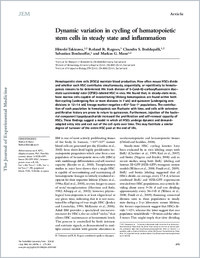Dynamic variation in cycling of hematopoietic stem cells in steady state and inflammation
- Takizawa, Hitoshi Institute for Research in Biomedicine (IRB), Faculty of Biomedical Sciences, Università della Svizzera italiana, Switzerland - Division of Hematology, University Hospital Zürich, CH-8091 Zürich, Switzerland
- Regoes, Roland R. Institute of Integrative Biology, ETH Zürich, CH-8092 Zürich, Switzerland
- Boddupalli, Chandra S. Institute for Research in Biomedicine (IRB), Faculty of Biomedical Sciences, Università della Svizzera italiana, Switzerland - Division of Hematology, University Hospital Zürich, CH-8091 Zürich, Switzerland
- Bonhoeffer, Sebastian Institute of Integrative Biology, ETH Zürich, CH-8092 Zürich, Switzerland
- Manz, Markus G. Institute for Research in Biomedicine (IRB), Faculty of Biomedical Sciences, Università della Svizzera italiana, Switzerland - Division of Hematology, University Hospital Zürich, CH-8091 Zürich, Switzerland
-
07.02.2011
Published in:
- Journal of experimental medicine. - 2011, vol. 208, no. 2, p. 273-284
English
Hematopoietic stem cells (HSCs) maintain blood production. How often mouse HSCs divide and whether each HSC contributes simultaneously, sequentially, or repetitively to hematopoiesis remains to be determined. We track division of 5-(and-6)-carboxyfluorescein diacetate succinimidyl ester (CFSE)–labeled HSC in vivo. We found that, in steady-state mice, bone marrow cells capable of reconstituting lifelong hematopoiesis are found within both fast-cycling (undergoing five or more divisions in 7 wk) and quiescent (undergoing zero divisions in 12–14 wk) lineage marker–negative c-Kit+ Sca-1+ populations. The contribution of each population to hematopoiesis can fluctuate with time, and cells with extensive proliferative history are prone to return to quiescence. Furthermore, injection of the bacterial component lipopolysaccharide increased the proliferation and self-renewal capacity of HSCs. These findings suggest a model in which all HSCs undergo dynamic and demand- adapted entry into and exit out of the cell cycle over time. This may facilitate a similar degree of turnover of the entire HSC pool at the end of life.
- Language
-
- English
- Classification
- Medicine
- License
- Open access status
- green
- Identifiers
-
- RERO DOC 324230
- DOI 10.1084/jem.20101643
- ARK ark:/12658/srd1319016
- Persistent URL
- https://n2t.net/ark:/12658/srd1319016
Statistics
Document views: 199
File downloads:
- Texte intégral: 228
